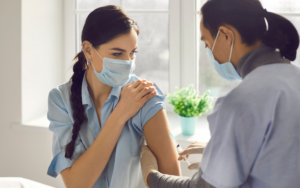
Amid the ever-evolving lifestyle changes that have come with the pandemic, and a surge in new research regarding the effects of the virus as well as the vaccine, the constant barrage of information from various sources can be overwhelming. However, with the vaccine becoming more available to the public, it’s important to be aware of the new recommendations that have emerged regarding the timing of mammograms and the COVID-19 Vaccine. You might be wondering how these two things are linked, so here’s what you need to know:
Swelling of the armpit’s lymph nodes (axillary lymphadenopathy) has commonly been associated with vaccines. It’s just a sign that your body is mounting an immune response and creating antibodies just as it does when there is an infection. However, discerning the root cause of lymphadenopathy comes down to timing, since it can also happen with other processes such as cancer.
Both the Moderna and Pfizer vaccine trials have reported axillary lymphadenopathy as a post-vaccine side effect. It is yet to be determined if the Johnson & Johnson vaccine will demonstrate a similar effect. One thing to note is that the swelling might not be noticeable with the kind of physical self-examination you do at home, so the actual prevalence of lymphadenopathy may be higher than what the clinical trials noted.
This is why the Society of Breast Imaging recommends getting your mammogram done before getting the vaccine to prevent abnormal findings that may be misattributed to cancer when in reality they are a result of the vaccine. The other option is to wait 4-6 weeks after the vaccine to get a mammogram. Researchers at the Department of Radiology at UT Southwestern recommend an ultrasound of the affected armpit 4-12 weeks after your scheduled second vaccination dose to make sure the swelling has gone. If it hasn’t, then ultrasound-guided biopsy is recommended to make sure it is not due to cancer.
Other researchers have provided similar guidelines: a group at the University of Pennsylvania recommend a follow-up ultrasound 6-8 weeks after the second vaccine dose; researchers at Massachusetts General Hospital also suggest getting one 6 weeks after vaccination, but only if the swelling is palpable at the 6-week mark. Ultimately, following these guidelines is recommended to prevent confusion regarding the cause of lymphadenopathy, reduce patient anxiety, avoid unnecessary testing, and avoid delays in screening.
Written by:
Emran Imami, MD, FACS, FAPWCA, MBA
Founder of TEPAS™ Breast Center
Nishath Rahman, 3rd year medical student at Burrell College of Medicine

